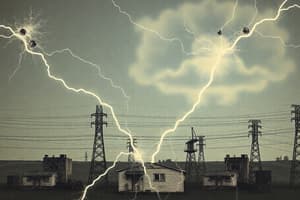Podcast
Questions and Answers
What is electrostatics?
What is electrostatics?
It is the study of electromagnetic phenomena that occur when there are no moving charges.
What is electrodynamics?
What is electrodynamics?
It is the study of the dynamics of electric charges and the electromagnetic forces that arise as a result.
What is the significance of Coulomb's law?
What is the significance of Coulomb's law?
It describes the force between two charged objects.
What property of matter does electric charge describe?
What property of matter does electric charge describe?
Like charges attract each other.
Like charges attract each other.
What is the SI unit of electric charge?
What is the SI unit of electric charge?
How is charge quantified?
How is charge quantified?
How many electrons must be removed from an object to have a charge of 1 C?
How many electrons must be removed from an object to have a charge of 1 C?
A comb rubbed with hair acquires a net charge of ______.
A comb rubbed with hair acquires a net charge of ______.
Which of the following will be positively charged when rubbed against each other?
Which of the following will be positively charged when rubbed against each other?
What happens when a body with an initial charge of 15 C loses 5 x 10^19 electrons?
What happens when a body with an initial charge of 15 C loses 5 x 10^19 electrons?
Study Notes
Types of Electricity
- Static Electricity: Involves the buildup of electric charges at rest.
- Current Electricity: Concerns the flow of electric charges in a circuit.
Electrostatics
- Definition: Study of electromagnetic phenomena with stationary charges.
- Key Contribution: William Gilbert expanded knowledge of static electricity and related material properties.
Electrodynamics
- Definition: Study of electric charge in motion and the electromagnetic forces produced.
Historical Development of Electricity
- Thales of Miletus: First recorded investigator of amber's electric properties.
- William Gilbert: Identified various substances exhibiting static electricity; introduced the term "electric."
- Benjamin Franklin (1752): Demonstrated the connection between lightning and electricity through the kite experiment.
Electric Charge
- Basic Property: Fundamental characteristic of matter carried by certain elementary particles.
- Types of Charges: Two types exist— like charges repel, while opposite charges attract.
- Unit of Measurement: Electric charge is measured in Coulombs (C).
Quantization of Charge
- Charge Expression: Any detectable charge can be expressed as q = ne, where e = 1.602 x 10^-19 C (elementary charge).
- Conservation of Charge: Charge is conserved during transfer; electrons are not created or destroyed.
Practical Applications and Questions
- To have a charge of 1 C, approximately 6.242 x 10^18 electrons must be removed from an object.
- A comb rubbed on hair gaining a charge of -0.96 C indicates electron gain through contact.
- For an initial charge of 15 C losing 5 x 10^19 electrons, calculate the final charge using the relationship between charge and electron count.
Triboelectric Series
- Definition: A ranking of materials based on their propensity to gain or lose electrons when in contact.
- Human Hair vs. Rubber: Human hair tends to become positively charged when rubbed against rubber.
Studying That Suits You
Use AI to generate personalized quizzes and flashcards to suit your learning preferences.
Related Documents
Description
This quiz covers basic concepts of electric charges, including static electricity and electrodynamics. Students will explore the definitions and principles behind these electromagnetic phenomena. Test your understanding of electricity and its various types in the context of Creative Technology 9.




